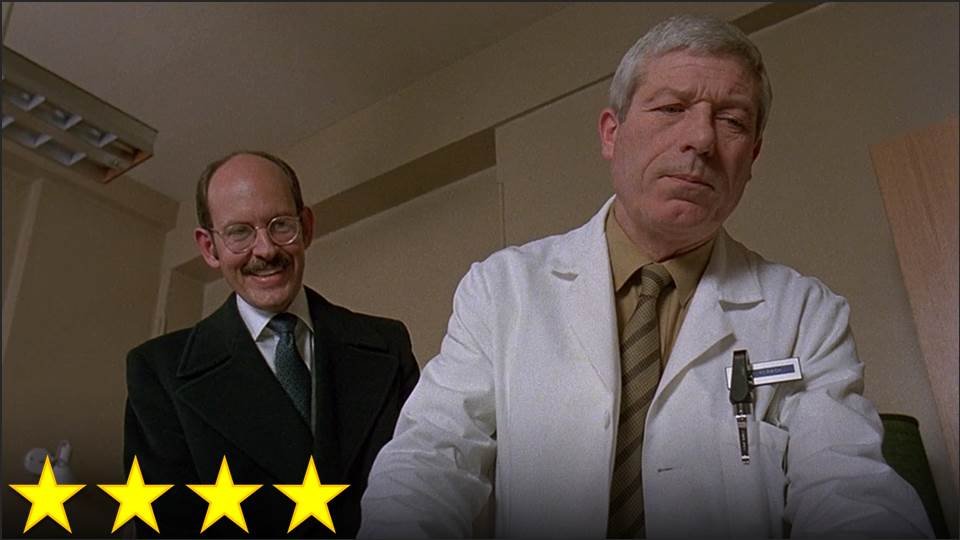People who have an obsessive passion for and enjoyment of Terry Gilliam films – or at least his more intense and bizarre creations like Time Bandits and Brazil – scare me. Guillermo del Toro, for example, was overjoyed to see his young daughter giggle with delight at the end of Time Bandits when (spoiler alert) the young protagonist’s parents explode. He’s happy that she found it funny that the boy’s parents died. It’s disgusting, but it’s all part of Gilliam – he has a sense of humor that goes for extreme intensity even if it crosses ethical lines, and some film enthusiasts really go for that. These films are, by and large, not too violent, but it’s often the merciless infliction of wild images and editing onto the audience mixed with the heartless infliction of “comedy without relief” onto the poor characters that makes these films so difficult for some to watch. Interestingly, upon watching Brazil again many years later for an audio commentary track, Gilliam found he wasn’t sure he liked the film very much because of how brutal its comedy and story were, but it is precisely the fact that the film is too much to handle in one sitting that draws some filmmakers to it.
Edgar Wright is one of the filmmakers who absolutely adores Brazil, and I think it really shows in Scott Pilgrim vs. the World: the most relentless movie ever made. It never stops. It just keeps blasting the viewer with more unconventional and experimental insanity that is incredibly difficult to wrap one’s mind around, all while retaining a formulaic story that’s perfectly easy to follow. The only way I was able to survive the movie was by taking breaks – I had to get up and walk to another room, or talk about what I’d just experienced with the friend of mine who so kindly subjected me to this film. I think I also could have used a snack break, and maybe a few naps. Technically, the film shouldn’t even be that hard to swallow: it’s not gory, it’s not scary, it’s not intensely dramatic (this film is, first and foremost, a comedy), it’s not addressing sensitive topics, it’s not making me feel “naked” the way The Graduate does, and it’s not flashing wild lights and vivid colors at me like that one irritating Canadian film. It’s simply difficult to process.
What makes it difficult is the unhinged creativity. There are no clear rules in this movie. When a man shows up with sexy demon hipsters singing a musical number as he flies around, you have to accept it, even though there is no setup for it. Honestly, the movie is so strange that, when one character’s ability to read minds is explained by the fact that he’s a vegan, I thought, “Oh, well that makes sense.” Relatively, that does make sense. It’s the best explanation you’ll get for anything in the movie. The Hollywood-trained mind isn’t ready for this.
What the film shares with Terry Gilliam is an unsettling contentment with the awkwardly terrifying conditions of its reality. There’s something very disturbing about seeing nobody react appropriately to the death of a boy’s parents – even if they are really bad parents – and watching old men in an office giddily force their bosses to walk off a blank from a skyscraper to fall to their whimsical deaths. When something that should alarm people is met with the wrong response, it creates an effect that just feels wrong on a moral level, and that’s all over this film. Right from the first fight scene, the way that other characters react to the brutality of what they’re witnessing feels off – it feels inhuman – and this makes the film tough to take on its first viewing (although I think it improves over time). However, what makes it possible for the viewer to adjust as the film progresses is the fact that the movie is largely operating on video game logic, where the impossible is often normalized in ways that would be unsettling if we thought about it, and Edgar Wright has forced us to think about it. He’s shown us a lot of our blind-spots in regards to video games simply by adapting the aspects of video games that no one has ever thought to adapt before.
I think that’s what I respect about the film. It tells its story in the way that it believes is the most fun, the most exciting, and the most respectful to the source, regardless of whether or not it’s what people are used to. There’s a sense that no one on set ever said, “Hey, this is going a bit too far, let’s dial it down.” Instead, they just followed every urge to do something fresh and exciting, and this philosophy actually paid off with a lot of really funny scenes. In fact, by putting the viewer in such a scared and vulnerable state, a lot of the comedy is made funnier, and the story’s messages are made more powerful. So, sure, I may have lost a significant percentage of my sanity from watching this film, but it was absolutely worth it to receive all of the joy the story brings and all of the power a filmmakers can have when he dares to be relentless.
(Still, that demon musical number is just plain stupid. Obviously.)






